Interface Customizations
|
|
First, I would like to describe some useful UI customizations, most of which can't be done by the GUI tools and administrative utilities.
Registry Values for Configuring Start Menu in Windows XP
In Chapter 1 we briefly discussed the methods of customizing the taskbar and Start menu in Windows XP by means of the standard Graphical User Interface (GUI). We have also noted that for most users, especially beginners, this method of customization is preferable. However, for advanced users there are lots of capabilities allowing one to customize Windows XP user interface by using Group Policy editor (Gpedit.msc) or by editing the registry directly. Let us cover these settings in more detail.
The most convenient way to edit the taskbar and Start menu features is provided by the Group Policy editor. To start editing these policies, proceed as follows:
-
Click Start, click Run, type mmc, and then click OK.
-
From the File menu, select the Add/Remove Snap-in command, go to the Standalone tab, and click Add.
-
From the Available Standalone Snap-ins list, select the Group Policy option and then click the Add button. When the Select Group Policy object window opens, select the Local Computer option to edit the local Group Policy object, or click Browse to find the Group Policy object that you want.
-
Click Finish, then Close, then OK. The Group Policy snap-in opens the Group Policy object for editing. Expand the console tree in the left pane of this window as follows: User Configuration / Administrative Templates / Start Menu and Taskbar (Fig. 12.1).

Fig. 12.1: Editing Start menu and taskbar policies using Group Policy editor
Let us consider the utilization of these policies on the example of the Force classic Start Menu Properties policy.
-
Go to the right pane of the Group Policy window and double-click the Force classic Start Menu item in the list of available policies. The Force classic Start Menu Properties window will open (Fig. 12.2). To view the explanation of the policy settings, click the Explain tab (Fig. 12.3).
-
To set the selected policy, set the Enabled radio button and click Apply.
-
Now, to view the effect of the application of this policy, open the Taskbar and Start Menu Properties window and go to the Start Menu tab. Notice that the Start menu radio button, which is present by default, has become unavailable, and the user is now forced to use the classic Windows NT/2000-style Start menu (Fig. 12.4).
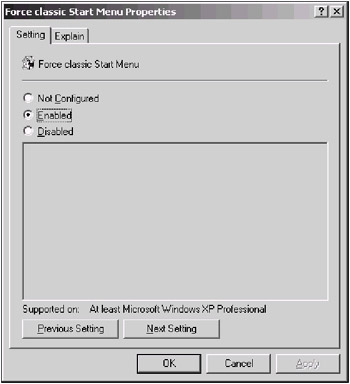
Fig. 12.2: The Setting tab of the Force classic Start Menu Properties windows
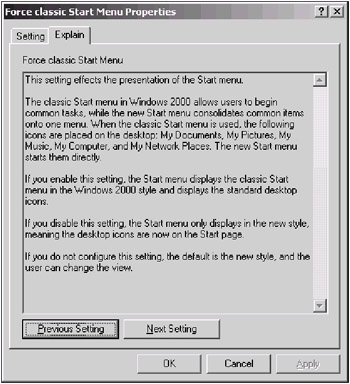
Fig. 12.3: The Explain tab of the policy properties window explains the effect of applying the currently selected policy
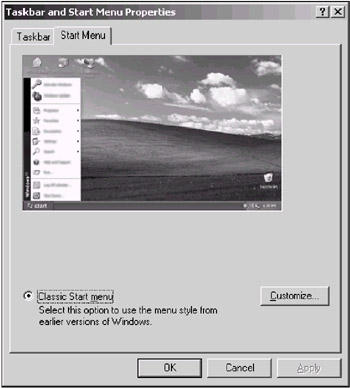
Fig. 12.4: The effect of applying the Force classic Start Menu policy
You can certainly achieve the same result by editing the registry directly. For example, by enabling the Force classic Start Menu policy you create the NoSimpleStartMenu registry value (REG_DWORD data type) under the HKEY_CURRENT_USER\Software\Microsoft\Windows\CurrentVersion\Policies\Explorer registry key (Fig. 12.5).
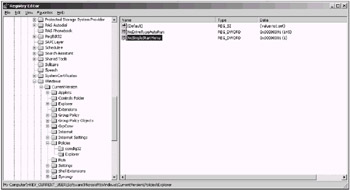
Fig. 12.5: The HKEY_CURRENT_USER\Software\Microsoft\Windows\CurrentVersion\Policies\Explorer registry key reflects the effect of applying the Force classic Start Menu policy
Other registry values that you can create to customize the taskbar and Start menu are listed below. Except when specially noted, all these values are of the REG_DWORD data type. They reside under the following registry key:
HKEY_CURRENT_USER\Software\Microsoft\Windows\CurrentVersion\Policies\Explorer
If the value is set to 1, the restriction is enabled, when the value is set to 0, the setting is disabled.
-
NoStartMenuPinnedList—removes pinned programs list from the Start menu, along with the Internet and E-mail checkboxes.
-
NoStartMenuMFUprogramsList—removes the frequently used programs list from the Start menu.
-
NoStartMenuMorePrograms—removes the More Programs option from the Start menu.
-
NoCommonGroups—removes common program groups from the Start menu (these are the items in the All Users profile in the More Programs list).
-
GreyMSIAds—displays partially installed programs in gray on the Start menu.
-
NoWindowsUpdate—disables and removes links to Windows Update. Also locks access to the windowsupdate.Microsoft.com site.
-
DisableMyPicturesDirChange—prevents the user from changing the path to his My Pictures folder.
-
DisableMyMusicDirChange—prevents the user from changing the path to his My Music folder.
-
DisableFavoritesDirChange—prohibits the user to change the path to his Favorites folder.
-
NoStartMenuMyMusic, NoSMMyPictures, NoFavoritesMenu, and NoRecentDocsMenu—removes all user shell folders (except My Documents) from the Start menu. Also removes appropriate checkboxes from the Start menu customization dialog.
-
NoSMMyDocs—removes My Documents folder from the Start menu along with appropriate checkbox from the Start menu customization dialog.
-
DisablePersonalDirChange—prevents the user from changing the path to his My Documents folder.
-
MaxRecentDocs—specifies the maximum number of shortcuts to recently used documents displayed in the Recent Documents submenu.
-
ClearRecentDocsOnExit—clears the history list when the user logs off.
-
NoRecentDocsMenu—removes the Recent Documents folder from the Start menu.
-
NoFavoritesMenu—removes the Favorites menu from the Start menu, and removes an appropriate checkbox from the Start menu customization dialog.
-
NoNetworkConnections—removes the Network Connections item from the Start menu, along with the corresponding checkbox which is normally available in the Start menu customization dialog.
-
NoStartMenuNetworkPlaces—removes the Network Places item from the Start menu and appropriate checkbox from the Start menu customization dialog.
-
NoRecentDocsNetHood—prohibits the adding of remote shared folders to the Network Places whenever the user opens a document in the shared folder.
-
NoSMHelp—removes the Help item from the Start menu (notice, however, that this will not prevent Help files from running).
-
NoFind—removes the Search command from the Start menu and disables the appropriate option in the Start menu customization dialog.
-
NoRun—removes the Run command from the Start menu and disables the appropriate checkbox in the Start menu customization dialog. Also disables the ability to run programs from Task Manager or by pressing <Winkey> + <R>.
-
MemCheckBoxInRunDlg—adds the Run in Separate memory Space checkbox to the Run dialog, which allows 16-bit programs to run in a separate VDM (Virtual DOS Machine).
-
NoSetTaskbar—prevents any changes from being made to the Taskbar and Start menu settings and removes the Taskbar and Start Menu item from Control Panel and from the Start menu.
-
NoInstrumentation—prevents the system from remembering the programs, paths and documents used.
-
NoUserNameInStartMenu—removes user name from the Start menu.
-
NoResolveSearch—prevents the system from searching the target drive to resolve a shortcut.
-
NoResolveTrack—prevents the system from using NTFS tracking features when resolving shell shortcuts.
-
ForceStartMenuLogoff—prevents users from removing the Logoff option from the Start menu.
-
StartmenuLogoff—disables the Logoff option in the Start menu and prevents users from adding it.
-
NoClose—removes the Turn Off Computer option from the Start menu and prevents users from shutting down the system using the standard shutdown UI.
-
NoChangeStartMenu—disables drag-and-drop modifications of the Start menu (other customization methods remain available, if they weren't explicitly disabled).
-
HKCU\Software\Microsoft\Windows\CurrentVersion\Policies\NonEnum\{20D04FE0-3AEA-1069-A2D8-08002B30309D}–removes My Computer item from the Start menu and disables the corresponding checkbox in the Start menu customization dialog.
| Note | If the values listed above are created under HKEY_CURRENT_USER, they will be applicable only to the currently logged on user. If you want them to apply to all new users, create them under the HKEY_USERS\.DEFAULT\Software\Microsoft\Windows\CurrentVersion\Policies\Explorer registry key. |
Changing the Behavior of Taskbar Grouping
By default, when you enable the Group similar taskbar buttons option at the Taskbar tab of the Taskbar and Start Menu Properties window, items are grouped only when the taskbar buttons begin to get too small, and then the item that you opened first, is grouped first. Take note of the fact, however, that Windows XP user interface only allows you to enable or disable the taskbar grouping feature, but doesn't provide you with the ability to change its behavior.
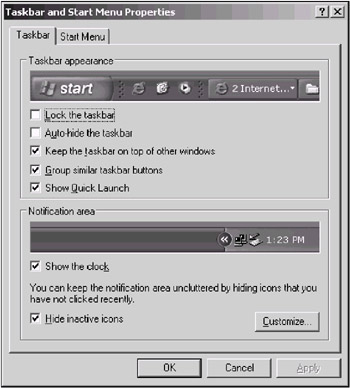
Fig. 12.6: The Taskbar tab of the Taskbar and Start Menu Properties dialog
Therefore, registry editing is the most appropriate way to change the default behavior of the taskbar buttons grouping feature. To customize it according to your requirements, create the TaskbarGroupSize value (REG_DWORD data type) under the following registry key:
HKEY_CURRENT_USER\Software\Microsoft\Windows\CurrentVersion\Explorer\Advanced
The taskbar grouping behavior depends on the values you assign to the TaskbarGroupSize registry value entry. These values are as follows:
-
0—(default) groups by age (oldest group first)
-
1—groups by size (largest group first)
-
2—groups any group of size 2 or more
-
3—groups any group of size 3 or more
Log off and then back on for this change to take effect.
Disabling Notification Area Balloon Tips
Actually, Notification Area balloon tips (Fig. 12.7) are a nice feature, especially for beginners. However, experienced users may become tired of them. For example, if one of your disks is running out of free space, you certainly wouldn't like to be persistently reminded of this fact. If you are like me, you'll certainly agree that sometimes these tips simply distract you from your current work.
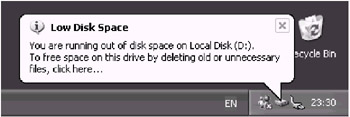
Fig. 12.7: An example of Notification Area balloon tip
Therefore, you'll definitely wish to disable the feature. To accomplish this, proceed as follows:
-
Start Regedit.exe, and expand the following key:
HKEY_CURRENT_USER\Software\Microsoft\Windows\CurrentVersion\Explorer\Advanced
-
Create a new REG_DWORD value and name it EnableBalloonTips. Set this value to 0.
-
Quit Registry Editor, then log off and then log back on.
| Note | These steps disable all Notification Area balloon tips for the current user. However, there is no way to disable balloon tips for specific program only. |
Preventing a Program from Being Displayed in the Most Frequently Used Programs List
If you like Windows XP Simple Start menu feature, you have undoubtedly noticed that it maintains a list of the most frequently used programs (Fig. 12.8). Now suppose that you want to continue using this feature, but don't want some specific programs to appear in that list. What can you do about it? Of course, you can right-click the required shortcut and select the Remove from This List command from the context menu. However, this will not prevent the program from appearing in that list if you use it some time later. You can also configure the Start menu to specify the number of shortcuts in the list of most frequently used programs (if you don't want the list of most frequently used programs to be displayed, set the value in the Number of programs on the Start menu field to 0) and clear this list if desired by clicking the Clear List button (Fig. 12.9).
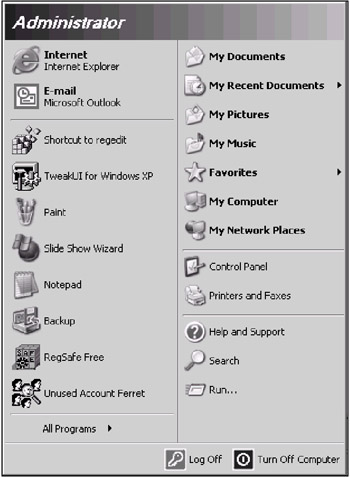
Fig. 12.8: Windows XP Simple Start menu
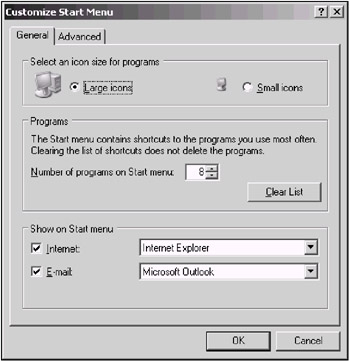
Fig. 12.9: The General tab of the Customize Start Menu window
This, however, doesn't solve the problem, since you only need to prevent some specific application (Regedit.exe, for example) from appearing in the list. At the same time, you don't want to disable this feature altogether.
This task can't be accomplished using the GUI tools. However, if you edit the registry, you can easily achieve the desired result. To do so, follow these steps:
-
Start Registry Editor (Regedit.exe).
-
Add an empty string value named NoStartPage to the following registry key, where Program name.exe is the name of the executable file that is used to start the program:
HKEY_CLASSES_ROOT\Applications\Program name.exe
-
Quit Registry Editor, and then restart the computer.
The application will be removed from the list of frequently used programs and will never appear in that list again.
Disabling Mail Notification Display on the Windows XP Welcome Screen
The Welcome Screen is displayed by default on Windows XP Personal Edition and Windows XP Professional-based computers that are not members of a domain. Under your name on the Welcome screen, there is a hyperlink that indicates the number of unread e-mail messages (Fig. 12.10), which, if you click it, reveals which account the messages are from, and how many each e-mail provider contains.
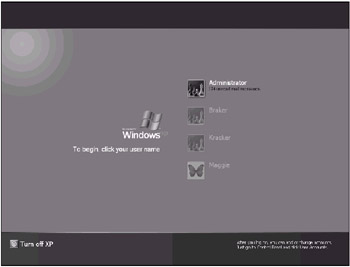
Fig. 12.10: By default, Welcome screen displays a hyperlink under a user name, indicating the number of unread e-mail messages
| Note | This e-mail hyperlink is only displayed if the e-mail client that supports this feature is running on your computer. Currently unread e-mail notification is supported by Outlook Express and Windows Messenger. If you use other mail clients, this notification will not appear. |
This feature can't be disabled using GUI tools, and Welcome Screen can't be reconfigured to populate the unread message count from a particular e-mail account.
Once again, to work around this behavior, you'll need to edit the registry.
If you want to disable the unread e-mail notification altogether, proceed as follows:
-
Start Regedit.exe, and expand the following registry key:
HKEY_CURRENT_USER\Software\Microsoft\Windows\CurrentVersion\UnreadMail (Fig. 12.11) -
Right-click the UnreadMail subkey and select the Permissions command from the right-click menu.
-
Click the System account, and then click to clear the Full Control and Special Permissions check boxes for Allow permissions. The System account should have Read permissions only (Fig. 12.12).
-
Click OK and quit Registry Editor.
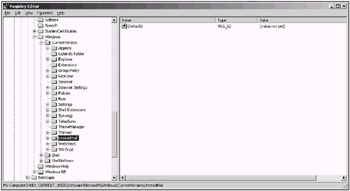
Fig. 12.11: The contents of the HKEY_CURRENT_USER\Software\Microsoft\Windows\CurrentVersion\UnreadMail registry key
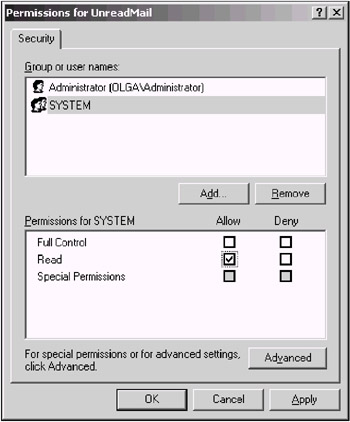
Fig. 12.12: To block the unread e-mail notification at the Welcome screen, provide the read-only permissions for the System account on the UnreadMail registry key
Now the System account will be prevented from updating Welcome Screen with any e-mail information, since it will be unable to modify the UnreadMail registry key.
If you have several e-mail accounts, and want to prevent only one of them from updating Welcome screen, expand the UnreadMail registry subkey. You'll notice that it contains nested subkeys for each of your e-mail accounts.
Select the subkey corresponding to the account that you want to prevent from updating Welcome Screen, and set the System permissions to that key to read-only.
|
|
EAN: 2147483647
Pages: 144